
NEERC
.pdf
ACM ICPC 2014–2015, Northeastern European Regional Contest
St. Petersburg – Barnaul – Tbilisi – Tashkent, December 7, 2014
Problem A. Alter Board
Input file: |
alter.in |
Output file: |
alter.out |
Little Dima gave his little brother Petya interactive chess board of size n £ m as a present. There are many awesome features of this board but one is Petya’s favorite. He can choose any rectangle formed by board squares and perform an inversion. Every white cell in the inverted rectangle becomes black and every black one becomes white.
In the initial state the board is colored in chess style, namely every cell is either black or white and every two cells that share a side have di erent colors. Little Petya wants to perform several inversions described above to turn all cells into the same color. He is impatient, so he asks you to provide him with instructions to do it with the minimal number of inversions.
Input
The input file contains two integers, n and m (1 · n, m · 50) — the number of rows and columns on the board, respectively.
Output
The first line of the output file must contain k — the number of inversions required to transform the board.
The following k lines must describe inversions, one per line. Each line must contains 4 integers — row and column of one of the corners of the corresponding rectangle and row and column of the opposite corner. Any two opposite corners can be used to specify a rectangle.
Rows of the board are numbered from 1 to n. Columns of the board are numbered from 1 to m.
Sample input and output
|
alter.in |
|
alter.out |
|
|
|
|
2 2 |
|
2 |
|
|
|
1 |
1 1 1 |
|
|
2 |
2 2 2 |
|
|
|
|
Page 1 of 15

ACM ICPC 2014–2015, Northeastern European Regional Contest
St. Petersburg – Barnaul – Tbilisi – Tashkent, December 7, 2014
Problem B. Burrito King
Input file: |
burrito.in |
Output file: |
burrito.out |
Two friends Albert and Barney came to the newly opened restaurant “Burrito King”. The restaurant had opened just yesterday, and Albert has got a special gift card, which allows the friends to get a free burrito. However, there is a constraint on the amount of ingredients — the burrito can contain at most gi grams of ingredient i for all i from 1 to n.
There are two satisfaction parameters ai and bi for each ingredient — the amount of Albert’s joy per gram of the corresponding ingredient, and the amount of Barney’s unhappiness per gram, correspondingly.
Therefore, the total Albert’s joy from the burrito is equal to:
∑n
si ¢ ai
i=1
The total Barney’s unhappiness from the burrito is equal to:
∑n
si ¢ bi
i=1
Here si is the number of grams of the i-th ingredient in the burrito. Note, that si is not necessarily an integer, and 0 · si · gi.
Albert wants to make his total joy from the burrito to be at least A. Barney is his best friend, so Albert wants Barney’s total unhappiness to be no more than B. Among all possible burritos that satisfy the above constrains, Albert wants to choose one that maximises his total joy.
Your task is to help Albert to choose si to satisfy these conditions or to find out that there is no solution.
Input
The first line contains three integers n, A, and B (1 · n · 100 000, 0 · A, B · 109), the number of ingredients, the least amount of Albert’s joy and the maximal amount of Barney’s unhappiness. Each of the following n lines contains a description of an ingredient: three integers gi, ai, bi (0 · gi, ai, bi · 100) — the maximal number of grams allowed, the amount of Albert’s joy per gram and the amount of Barney’s unhappiness per gram.
Output
The first line of the output must contain two real numbers — the maximal amount of his joy and the amount of Barney’s unhappiness that Albert can obtain, satisfying the conditions in the problem statement, or “¡1 ¡1”, if Albert cannot satisfy the conditions.
If the conditions are satisfiable the second line must contain n real numbers — the amount of each ingredient in grams.
Your output must have an absolute or relative error of at most 10−8.
Any way to reach maximal Albert’s joy that satisfies the given conditions can be printed.
Sample input and output
burrito.in |
burrito.out |
|
|
2 5 5 |
5.5 5 |
2 2 1 |
2 0.75 |
2 2 4 |
|
|
|
2 5 5 |
-1 -1 |
2 2 2 |
|
2 2 4 |
|
|
|
Page 2 of 15

ACM ICPC 2014–2015, Northeastern European Regional Contest
St. Petersburg – Barnaul – Tbilisi – Tashkent, December 7, 2014
Problem C. Cactus Generator
Input file: |
cactus.in |
Output file: |
cactus.out |
NEERC featured a number of problems about cactuses — connected undirected graphs in which every edge belongs to at most one simple cycle. Intuitively, cactus is a generalization of a tree where some cycles are allowed.
In 2005, the first year where a problem about cactuses appeared, the problem was called simply “Cactus”. In 2007 it was “Cactus Reloaded”, in 2010 it was called “Cactus Revolution”, and in 2013 it was called
“Cactus Automorphisms”. Here is an example of cactus that was used in those problems:
6 |
|
|
|
|
|
7 |
|
5 |
13 |
|
12 |
8 |
|
4 |
|
10 |
11 |
|
|||||
|
|
|
|
||
3 |
|
|
|
15 |
|
9 |
|
|
|||
|
|
|
|
|
|
214
1
For four years judges had to generate test files for cactuses with thousands of vertices. Of course, a number of test generators of ever-increasing complexity were built, culminating with a domain-specific language called CGL — Cactus Generator Language. CGL can compactly define a big cactus for purposes of a test. In this problem you have to parse a simplified version of this language, which we call SCGL — Simple Cactus Generator Language, and output a resulting cactus.
A cactus has to be output by listing the minimal set of edge-distinct paths that cover the whole graph.
The syntax of SCGL cactus definition is represented by the graph non-terminal in the grammar that is given below using the Extended Backus-Naur Form:
graph |
= |
“c” |
|
j |
“c(” list “)” |
|
j |
“loop(” list “)” |
|
j |
“t(” list “)” |
list |
= |
graph f “,” graph g |
|
j |
(number j range j variable ) [ “,” graph ] |
number |
= |
nzdig f “0” j nzdig g |
nzdig |
= |
“1” j “2” j ... j “8” j “9” |
range |
= |
“range(” variable “,” numvar “,” numvar “)” |
variable |
= |
“A” j “B” j ... j “Y” j “Z” |
numvar |
= |
number j variable |
A graph production rule denotes a graph with two labeled vertices — the first and the last. Graphs definition rules have the following semantics:
Page 3 of 15

ACM ICPC 2014–2015, Northeastern European Regional Contest
St. Petersburg – Barnaul – Tbilisi – Tashkent, December 7, 2014
²The basic building block c denotes a graph with just two vertices (one is the first and the other one is the last) and one edge.
²The c(σ) rule connects a specified list of graphs σ from left to right into a chain, merging the last vertex of the first graph in the list with the first vertex of the second graph in the list, the last vertex of the second graph with the first of the third one, and so on. The resulting graph’s first vertex is the first vertex of the first graph in the list, and the resulting graph’s last vertex is the last vertex of the last graph in the list.
²The loop(σ) rule connects a specified list of graphs σ from left to right, merging the last vertex of the first graph in the list with the first vertex of the second graph in the list, and so on like in c(σ), while the last vertex of the last graph in the list is merged with the first vertex of the first graph in the list to form a loop. The resulting graph’s first and last vertices are the first and the last vertices of the first graph in the list. Loop can be applied only to lists with more than one graph.
²The t(σ) rule connects a specified list of graphs σ, merging their first vertices. The resulting graph’s
first and last vertices are the first and the last vertices of the first graph in the list.
The list of graphs is either specified explicitly, by a comma-separated list, or using a list repetition with a number, a range, or a variable, optionally followed by a comma and a graph. When a graph is not explicitly specified in a list repetition, then the given graph is assumed to be c.
The simplest list repetition is defined using a number non-terminal. It denotes a list of graphs with the specified integer number of copies of the given graph.
A range list repetition is defined by range(ν, α, β) rule which has three components — a variable ν, and numbers α and β. If ξ character sequence is a graph, then cjloopjt(range(ν, α, β), ξ) are called rangeenabled rules and the variable ν is called a bound variable in ξ. In the context of a range-enabled rule, ξ is repeated jβ ¡ αj + 1 times to form a list. Every occurrence of variable ν in ξ is replaced by consecutive integer numbers between α and β inclusive in ascending order. That produces a list of jβ ¡ αj + 1 graphs, which are then connected according the specification of the corresponding range-enabled rule. The α and
β themselves might refer to variables that are bound in the outer range-enabled rule.
In a well-formed graph:
² |
each variable non-terminal (a letter from A to Z) occurs at most once as ν in range(ν, α, β) rules; |
² |
all other occurrences of variable non-terminal that are allowed by the grammar are bound. |
Note, that if a character sequence ξ is a graph, then ξ, c(ξ), c(1, ξ), t(ξ), and t(1, ξ) all denote the same graph. On the other hand, neither loop(ξ) nor loop(1, ξ) are allowed.
The following examples illustrate these basic rules. The graphs have their first and last vertices marked with letters F and L correspondingly.
|
|
c |
|
|
c(2) |
|
|
|
|
|
|
c(3) |
|
|
|
|
|
|
|
t(c(3),c,c) |
|
|
|
|
c(2,t(c(2),c,c)) |
|||||||||||||
|
|
|
|
|
|
|
|
|
|
|
|
|
|
|
|
|
|
|
|
|
|
|
|
|
|
|
|
|
|
|
|
|
|
|
|
|
||
|
|
|
|
|
|
|
|
|
|
|
|
|
|
|
|
|
|
|
|
|
|
|
|
|
|
|
|
|
|
|
|
|
|
|
|
|
|
|
F |
L |
F |
|
|
L |
F |
|
|
L |
F |
|
|
|
|
|
L |
F |
|
|
L |
||||||||||||||||||
|
|
|
|
|
|
loop(c,c,c) |
|
loop(c(3),c,c) |
loop(4) |
|
loop(2,t(c(3),c,c)) |
|||||||||||||||||||||||||||
|
|
|
|
|
|
|
|
|
|
|
|
|
|
|
|
|
|
|
|
|
|
|
|
|
|
|
|
|
|
|
|
|
|
|
||||
|
|
|
|
|
|
|
|
|
|
|
|
|
|
|
|
|
|
|
|
|
|
|
|
|
|
|
|
|
|
|
|
|
|
|
|
|
|
|
|
|
|
|
|
|
|
F |
|
|
L |
F |
|
|
L |
|
F |
L |
F |
|
|
|
|
|
|
L |
|||||||||||||
|
|
|
|
t(2) |
|
t(c,c(2)) |
|
c(c,t(2)) |
|
|
|
|
c(c(2),t(3)) |
|
|
|
t(range(A,1,3)) |
|||||||||||||||||||||
|
|
|
|
|
|
|
|
|
|
|
|
|
|
|
|
|
|
|
|
|
|
|
|
|
|
|
|
|
|
|
|
|||||||
|
|
|
|
|
|
|
|
|
|
|
|
|
|
|
|
|
|
|
|
|
|
|
|
|
|
|
|
|
|
|
|
|
|
|
|
|
|
|
|
|
|
F |
|
L |
F |
|
L |
|
|
F |
L |
F |
|
|
|
|
|
L |
|
F |
|
L |
|||||||||||||||
Page 4 of 15
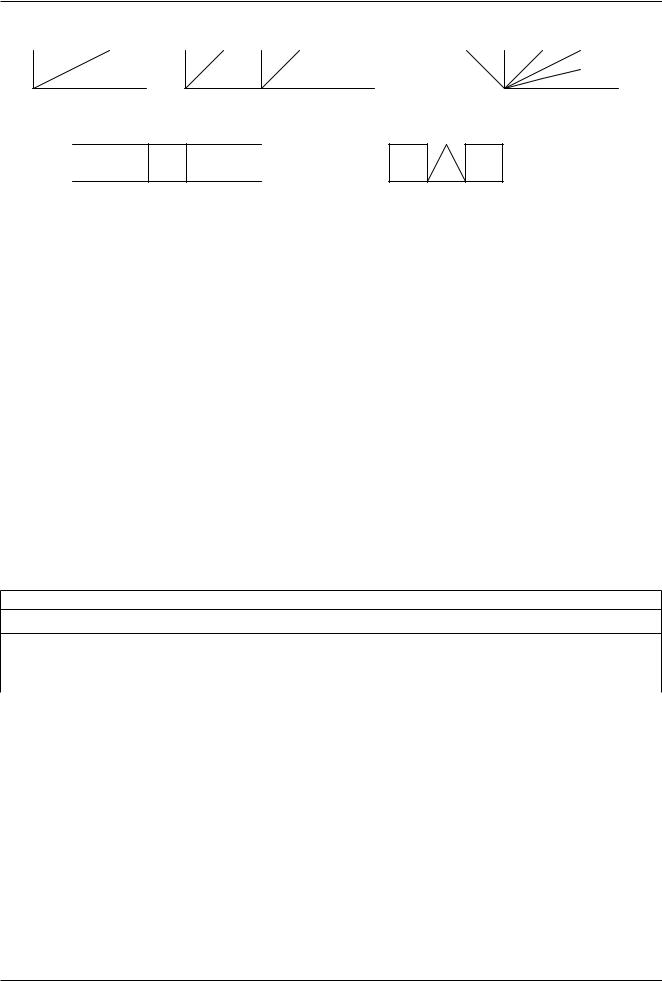
ACM ICPC 2014–2015, Northeastern European Regional Contest
St. Petersburg – Barnaul – Tbilisi – Tashkent, December 7, 2014
t(range(A,1,3),c(A)) c(range(N,2,3),t(c(N),c,c)) t(range(X,1,3),t(range(Y,3,X),c(X)))
L |
|
|
L |
F |
F |
L |
F |
loop(range(N,1,4),t(c,c(2))) c(range(I,1,3),loop(c,c,c(range(J,I,2))))
F L F L
Input
The input file contains a single line with a well-formed cactus definition in SCGL. While the syntax and semantics of SCGL themselves do not guarantee that the resulting graph is a cactus, the input file for this problem always defines a cactus — every edge belongs to at most one simple cycle and there are no multiple edges between vertices. For example, neither loop(3,loop(3)) nor loop(2) are possible.
The line in the input file is at most 1000 characters long and defines a cactus with at most 50 000 vertices. Integer numbers represented by number non-terminals do not exceed 50 000.
Output
The first line of the output file must contain two integer numbers n and m. Here n is the number of vertices in the graph. Vertices are numbered from 1 to n, where 1 is the number of the first vertex of the graph and n is the number of the last vertex of the graph. The other vertices can be numbered arbitrarily. Edges of the graph are represented by a set of edge-distinct paths, where m is the minimal number of such paths.
Each of the following m lines must contain a path in the graph. A path starts with an integer number ki (ki ¸ 2) followed by ki integers from 1 to n. These ki integers represent vertices of a path. A path can go to the same vertex multiple times, but every edge must be traversed exactly once in the whole output
file.
Sample input and output
cactus.in
c(c,t(loop(3),c(c,loop(6))),loop(c,c,t(c,loop(4))))
|
|
cactus.out |
|
|
|
15 1 |
|
|
|
|
|
19 1 |
2 9 10 11 12 13 10 15 9 14 2 3 4 5 6 7 8 3 |
|
|
||
|
|
|
|
|
|
|
|
|
|
|
|
|
|
cactus.in |
|
|
cactus.out |
|
|
|
|
|
|
c |
|
|
2 1 |
|
|
|
|
|
2 1 |
2 |
|
|
|
|
|
|
|
c(2) |
|
|
3 1 |
|
|
|
|
|
3 1 |
2 3 |
|
|
|
|
|
|
|
c(3) |
|
|
4 1 |
|
|
|
|
|
4 1 |
2 3 |
4 |
|
|
|
|
|
|
t(c(3),c,c) |
|
6 2 |
|
|
|
|
|
|
2 1 |
2 |
|
|
|
|
5 3 |
1 4 |
5 6 |
|
|
|
|
|
|
c(2,t(c(2),c,c)) |
|
9 3 |
|
|
|
|
|
|
3 2 |
1 3 |
|
|
|
|
3 4 |
5 6 |
|
|
|
|
5 1 |
7 5 |
8 9 |
|
|
|
|
|
|
Page 5 of 15
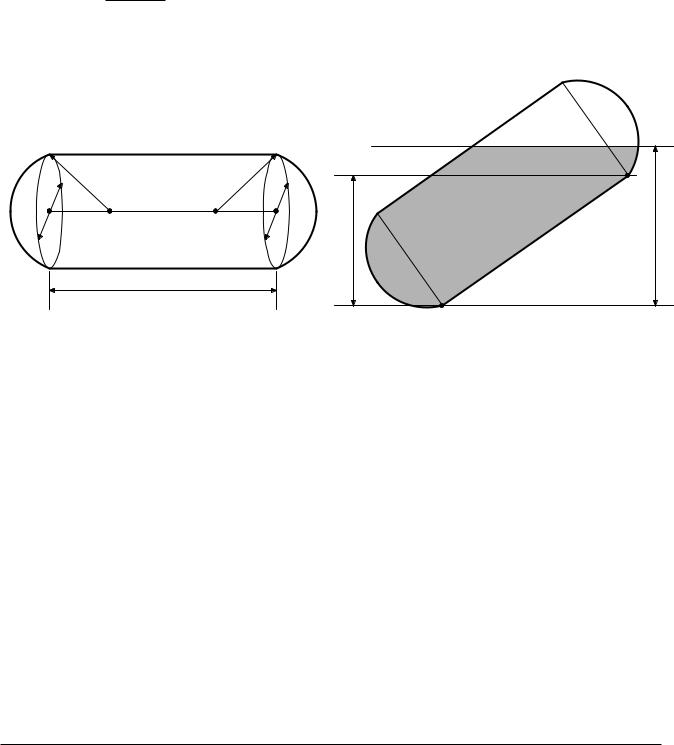
|
ACM ICPC 2014–2015, Northeastern European Regional Contest |
|
St. Petersburg – Barnaul – Tbilisi – Tashkent, December 7, 2014 |
|
|
Problem D. Damage Assessment |
|
Input file: |
damage.in |
Output file: |
damage.out |
A tank car that transports gasoline via rail road has a shape of cylinder with two spherical caps at the sides. The cylinder has a diameter d and a length l. The spherical caps have a radius r (2r ¸ d). There was the rail road accident and the tank car had derailed. It now lies on the ground and some of the stored gasoline had flown out. The damage assessment must be performed. The location of the tank on the ground was established by measuring its tilt as the height di erence t from the bottom points of the cylinder on its left and right sides (0 · t · l). The level of gasoline in the tank was established by measuring the height di erence h from the bottom point of the cylinder and the top level of gasoline.
For the purpose of this problem, the top level of gasoline always intersects the cylinder part of the tank
√
(0 · h · t + d 1 ¡ (t/l)2).
Your task is to figure out how much gasoline was left in the tank.
r |
r |
d |
d |
|
h |
|
t |
|
l |
Tank schematic drawing |
Tank location and gasoline level |
Input
The input file consists of a single line with five integer numbers — d, l, r, t and h, which represent the diameter and the length of the tank’s cylinder part, the radius of its spherical caps, tilt and gasoline level measurements. They are all expressed in millimeters (1 millimeter = 10−3 meters), they satisfy all constraints expressed in the problem statement and d, l ¸ 100, d, l, r · 10 000.
Output
Write a single real number to the output file — the volume of gasoline in the tank in liters (1 liter = 10−3 cubic meters). The absolute error of the answer must not exceed 0.1 liters.
Sample input and output
damage.in |
damage.out |
|
|
3000 6000 1600 0 3000 |
50974.56 |
|
|
3000 6000 1600 3441 4228 |
40728.90 |
|
|
Page 6 of 15
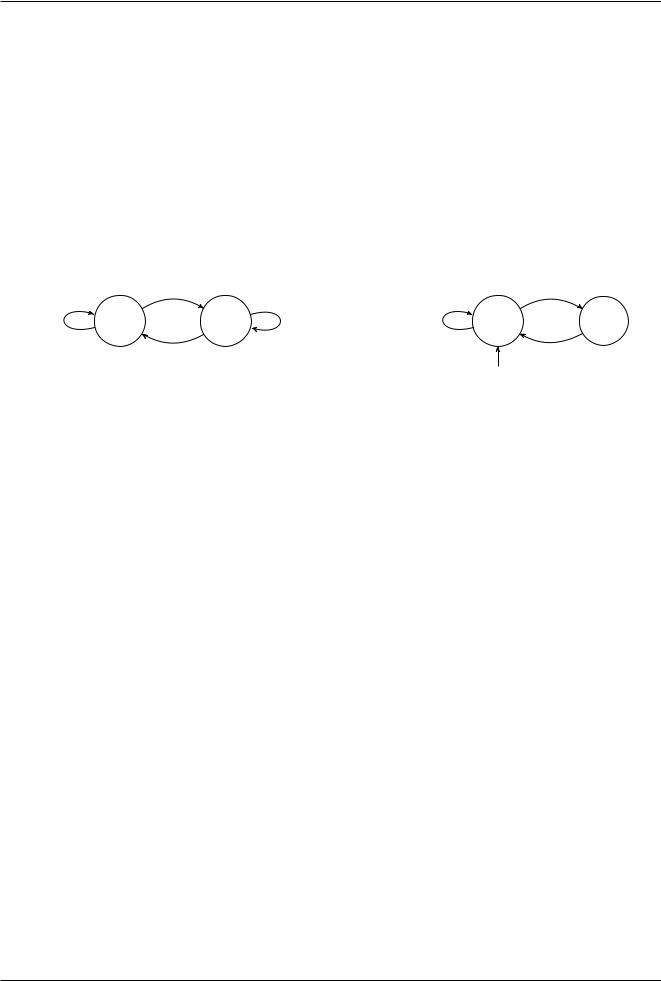
ACM ICPC 2014–2015, Northeastern European Regional Contest
St. Petersburg – Barnaul – Tbilisi – Tashkent, December 7, 2014
Problem E. Epic Win!
Input file: |
epic.in |
Output file: |
epic.out |
A game of rock-paper-scissors is played by two players who simultaneously show out their moves: Rock, Paper, or Scissors. If their moves are the same, it’s a draw. Otherwise, Rock beats Scissors, Paper beats
Rock, and Scissors beat Paper.
The described procedure can be repeated many times. In this problem, two Finite State Machines (FSMs) will compete in a series of rounds. (Formally speaking, by FSMs we mean Moore machines in this problem.)
An FSM for playing rock-paper-scissors has finitely many states. Each state is described by the following: what move the FSM will make in the upcoming round, and what will be the new state in case of its opponent playing Rock, Paper, and Scissors.
|
|
S |
|
|
|
P |
R, P |
play R |
play P |
R, P |
R, S |
play P |
play S |
|
|
S |
|
|
start |
R, P, S |
|
|
|
|
|
|
Fortunately, you know your opponent FSM — the entire scheme except for one thing: you do not know the initial state of that FSM.
Your task is to design your own FSM to fight the given one. Your FSM must beat the opponent in at least 99% of the first 1 billion rounds. That’s what we call an epic win!
Input
The input file contains a description of the opponent FSM in the following format.
The first line contains an integer n (1 · n · 100) — the number of states in the FSM. States are numbered from 1 to n. Each of the following n lines contains a description of the state: a character ci denoting the move made by FSM and integers ri, pi, si denoting the next state in case of seeing Rock,
Paper, or Scissors respectively (ci can be ”R”, ”P”, or ”S”; 1 · ri, pi, si · n).
Output
Write to the output the description of your FSM in the same format.
The initial state of your FSM is the first state.
The number of states may not exceed 50 000.
Sample input and output
|
epic.in |
|
epic.out |
|
|
|
|
2 |
|
2 |
|
R 1 1 2 |
P 1 2 1 |
||
P |
2 2 1 |
S |
1 1 1 |
|
|
|
|
The picture in the problem statement illustrates the opponent FSM given in the above sample input and a possible solution of yours given in the sample output.
Opponent FSM keeps playing Rock or Paper (depending on its initial state) until it sees Scissors — seeing Scissors triggers a change in its behaviour.
One way to beat such FSM is to play Paper. If your opponent keeps playing Rock, just continue playing Paper and thus win. If the opponent FSM is playing Paper, trigger it to playing Rock by playing Scissors once, and then it’ll keep playing Rock and you’ll keep beating it with your Paper.
Page 7 of 15

ACM ICPC 2014–2015, Northeastern European Regional Contest
St. Petersburg – Barnaul – Tbilisi – Tashkent, December 7, 2014
Problem F. Filter
Input file: |
filter.in |
Output file: |
filter.out |
You are working on a new high-performance database engine — Instant Compression and Processing Codec (ICPC). ICPC stores user activity records. Each user activity record has an integer user identifier.
The records are stored in a number of data files. Each data file is compressed and can contain records from multiple users, however ICPC has to process queries that look for a specific subsets of users. In order to do so, there has to be a way to quickly determine which data files may contain records for a specific user before attempting to decompress them, which may be a long and CPU-consuming process.
ICPC uses an algorithm called Bloom Filter. The way it is implemented in ICPC is described below. For each ICPC database the following integer parameters are chosen:
²m is the number of bits in the filter;
²f is the number of hash functions in the filter;
²ai are the parameters for hash functions for 0 · i < f.
A value of the bloom filter is computed for each data file. The data file’s bloom filter is a vector of m bits. A bit number j (0 · j < m) is set to one if and only if there is a record in this data file for some user identifier uk, such that for some hash function i (0 · i < f) the following equality holds:
j = (uk ¢ ai) mod m |
(1) |
Your task is to implement ICPC filtering logic. You are given filter parameters and values for a number of data files and a set of user identifiers. Your task is determine which data files may contain record with at least one user identifier from the specified set. A data file may contain a record with a user identifier uk if and only if for all i (0 · i < f) all the bits j given by equality (1) in its filter value are set to one.
Input
The first line of the input file contains filter parameters — integer numbers m, f, and ai for 0 · i < f
(1 · m · 1000, 1 · f · 100, 1 · ai < 231).
The second line of the input file contains an integer n — the number of data files (1 · n · 1000). Each of the following n lines contains bloom filter value of the corresponding file in hexadecimal form. Each value is represented by a string of dm/4e hexadecimal digits (one of 0123456789abcdef). The first digit of the string represents bits 0–3 of the value (stored in order from the least significant bit of a hexadecimal digit to the most significant bit), the second digit — bits 4–7, the third — 8–11, etc. When m mod 4 =6 0, then the last hexadecimal digit represents the last m mod 4 bits of the value in its least significant bits.
The following line of the input file contains an integer q — the number of user identifiers in a query
(1 · q · 1000), followed by q integers uk — the set of distinct user identifiers in the query (1 · uk < 231).
Output
Write a line with the integer number s to the output file — the number of data files that may contain a record with at least one user identifier from the specified set, followed by s numbers dt (0 · dt < n) — the 0-based numbers of the corresponding data files in ascending order.
Sample input and output
|
|
filter.in |
filter.out |
|
|
|
|
23 4 3 |
5 7 11 |
2 0 2 |
|
3 |
|
|
|
effde7 |
|
|
|
c07902 |
|
|
|
0800c1 |
|
|
|
3 |
2 4 6 |
|
|
|
|
|
|
Page 8 of 15
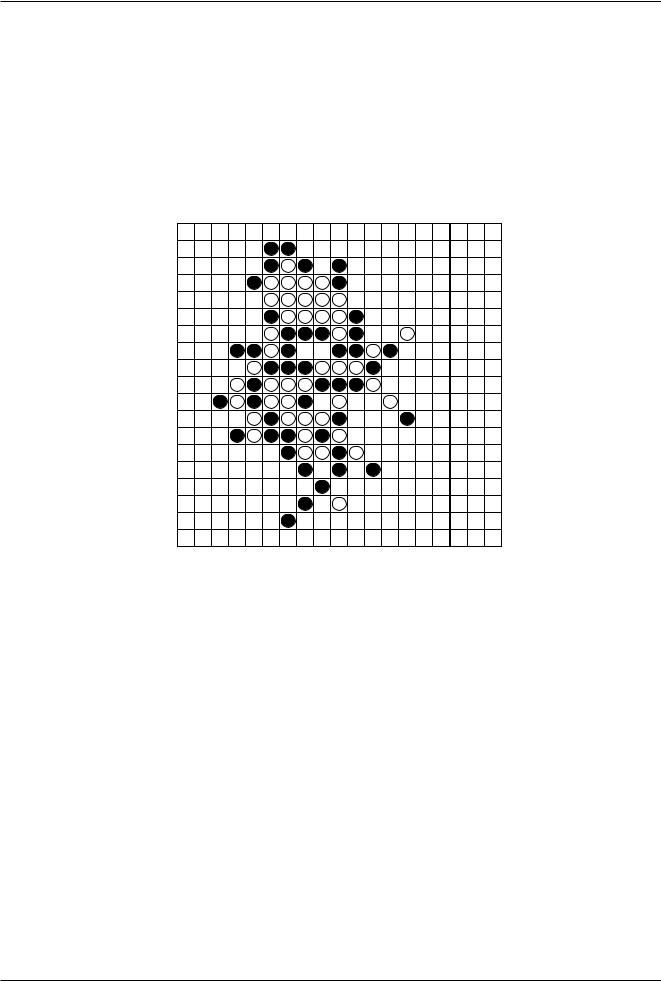
ACM ICPC 2014–2015, Northeastern European Regional Contest
St. Petersburg – Barnaul – Tbilisi – Tashkent, December 7, 2014
Problem G. Gomoku
Input file: |
standard |
input |
Output file: |
standard |
output |
This is an interactive problem.
Gomoku is a two-player game on a two-dimensional grid. Each cell of the grid can be either empty, contain the first player’s mark (black), or contain the second player’s mark (white), but not both. Initially the entire grid is empty. Two players make alternating moves, starting with the first player. At each move, a player can put her mark into exactly one empty cell. The first player to have her five adjacent marks in a single row wins. The winning row can be either vertical, horizontal or diagonal.
19
18
17
16
15
14 13
12 11 10 9
8 7 6
5
4
3
2
1  1 2 3 4 5 6 7 8 9 10 11 12 13 14 15 16 17 18 19
1 2 3 4 5 6 7 8 9 10 11 12 13 14 15 16 17 18 19
Position where the second player (white marks) had won.
The players use a 19 £ 19 grid in this problem. If the entire grid gets filled with marks but no player has won, the game is declared a draw.
The first player uses the following strategy: as the first move, she puts her mark into the center cell of the grid. At every other move, she picks such a move that maximizes the score of the resulting position.
In order to find the score of a position, the first player considers all possible places where the winning combination might eventually form — in other words, all horizonal, vertical and diagonal rows of five consecutive cells on the board (of course, they may overlap each other). If such a row contains both the first player’s marks and the second player’s marks, it is disregarded. If such a row contains no marks, it is disregarded as well. For each row with exactly k (1 · k · 5) marks of the first player and no marks of the second player, add 502k−1 to the score of the position. For each row with exactly k marks of the second player and no marks of the first player, subtract 502k from the score of the position. Finally, add a random integer number between 0 and 502 ¡ 1 to the score. This random number is chosen uniformly.
In case when several moves of the first player have equal scores (such ties are quite rare because of the random addition mentioned above), the first player picks the one with the smallest x-coordinate, and in case of equal x-coordinates, the one with the smallest y-coordinate.
Your task is to write a program that plays the second player and beats this strategy.
Your program will play 100 games against the strategy described above, with di erent seeds of random generator. Your program must win all these games.
Page 9 of 15
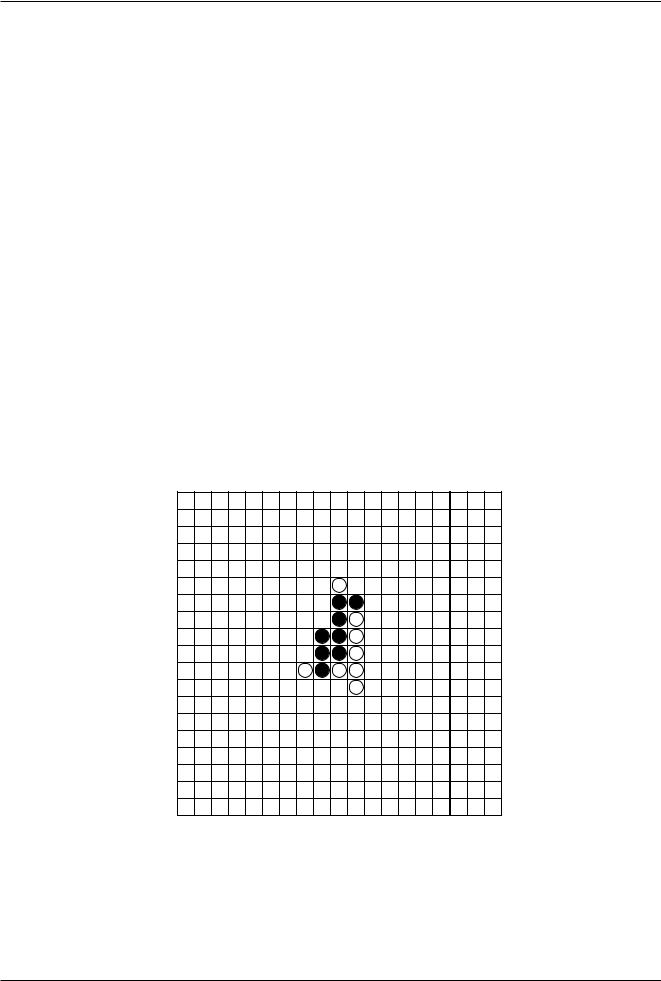
ACM ICPC 2014–2015, Northeastern European Regional Contest
St. Petersburg – Barnaul – Tbilisi – Tashkent, December 7, 2014
Interaction protocol
On each step, your program must:
1.Read numbers x and y from the input.
2.If both these numbers are equal to ¡1 then the game is over and your program must exit.
3. Otherwise these numbers are the coordinates of the first player’s move (1 · x, y · 19).
4.Print the coordinates of the move of the second player, followed by line end. Don’t forget to flush the output bu er.
Sample input and output
In the example below the first player does not use the strategy from the problem statement. The example is given only to illustrate the interaction format.
standard input |
standard output |
|
|
10 10 |
11 10 |
10 11 |
11 11 |
10 12 |
10 9 |
10 13 |
10 14 |
9 10 |
8 9 |
9 11 |
11 9 |
9 9 |
11 12 |
11 13 |
11 8 |
-1 -1 |
|
|
|
19
18
17
16
15
14
13
12
11
10
9
8
7
6
5
4
3
2
1
1 2 3 4 5 6 7 8 9 10 11 12 13 14 15 16 17 18 19
Final position from the example.
Note
There are many variations of Gomoku rules in the world. Please only consider the rules described in this problem statement.
Page 10 of 15
